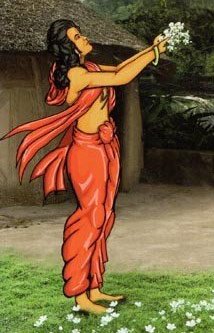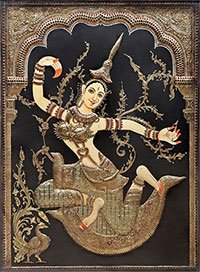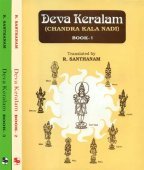Harina, Hāriṇa, Hariṇa: 30 definitions
Introduction:
Harina means something in Buddhism, Pali, Hinduism, Sanskrit, Marathi, Jainism, Prakrit, Hindi, biology. If you want to know the exact meaning, history, etymology or English translation of this term then check out the descriptions on this page. Add your comment or reference to a book if you want to contribute to this summary article.
In Hinduism
Ayurveda (science of life)
Dietetics and Culinary Art (such as household cooking)
Source: Shodhganga: Dietetics and culinary art in ancient and medieval IndiaHariṇa (हरिण) refers to a type of Jāṅghala meat and is mentioned as being beneficial (hita) to the body according to the 17th century Bhojanakutūhala (dravyaguṇāguṇa-kathana), and is commonly found in literature dealing with the topics of dietetics and culinary art, also known as Pākaśāstra or Pākakalā.—The dravyaguṇāguṇa section contains the discussions on different food articles and their dietetic effects according to the prominent Ayurvedic treatises. Here In the māṃsa (meats) group Hariṇa is mentioned as beneficial to the body (hita).
Veterinary Medicine (The study and treatment of Animals)
Source: Shodhganga: Portrayal of Animal Kingdom (Tiryaks) in Epics An Analytical studyHariṇa (हरिण) refers to the Four-horned Chinkara (Gazella bennettil), according to scientific texts such as the Mṛgapakṣiśāstra (Mriga-pakshi-shastra) or “the ancient Indian science of animals and birds” by Hamsadeva, containing the varieties and descriptions of the animals and birds seen in the Sanskrit Epics such as the Ramayana and Mahabharata.
Unclassified Ayurveda definitions
Source: Wisdom Library: Āyurveda and botanyHariṇa (हरिण) is a Sanskrit word referring to the “red deer”. The meat of this animal is part of the māṃsavarga (‘group of flesh’), which is used throughout Ayurvedic literature. The animal Hariṇa is part of the sub-group named Jāṅgalamṛga, refering to “animals living in forests”. It was classified by Caraka in his Carakasaṃhitā sūtrasthāna (chapter 27), a classical Ayurvedic work. Caraka defined such groups (vargas) based on the dietic properties of the substance.
Source: archive.org: Sushruta samhita, Volume IHariṇa (हरिण)—Sanskrit word for “red deer”. This animal is from the group called Jaṅghāla (large-kneed). Jaṅghāla itself is a sub-group of the group of animals known as Jāṅghala (living in high ground and in a jungle).
The venison of the Harina (red) species is sweet in taste and digestion, appetising, aromatic, cool, light, and suppresses the discharge of stool and urine and pacifies the deranged humours.

Āyurveda (आयुर्वेद, ayurveda) is a branch of Indian science dealing with medicine, herbalism, taxology, anatomy, surgery, alchemy and related topics. Traditional practice of Āyurveda in ancient India dates back to at least the first millenium BC. Literature is commonly written in Sanskrit using various poetic metres.
Purana and Itihasa (epic history)
Source: archive.org: Puranic EncyclopediaHariṇa (हरिण).—A nāga which belonged to the Airāvata family. It was burnt to death at the Sarpasatra of Janamejava. (Ādi Parva, Chapter 57, Verse 11).
Source: Cologne Digital Sanskrit Dictionaries: The Purana Index1) Hariṇa (हरिण).—See Haraya.*
- * Brahmāṇḍa-purāṇa III. 7. 179; 22. 45.
2) Hāriṇa (हारिण).—The flesh of the deer used for śrāddha.*
- * Matsya-purāṇa 17. 31.
Hariṇa (हरिण) is a name mentioned in the Mahābhārata (cf. I.52.10, I.57) and represents one of the many proper names used for people and places. Note: The Mahābhārata (mentioning Hariṇa) is a Sanskrit epic poem consisting of 100,000 ślokas (metrical verses) and is over 2000 years old.

The Purana (पुराण, purāṇas) refers to Sanskrit literature preserving ancient India’s vast cultural history, including historical legends, religious ceremonies, various arts and sciences. The eighteen mahapuranas total over 400,000 shlokas (metrical couplets) and date to at least several centuries BCE.
Shilpashastra (iconography)
Source: Shodhganga: The significance of the mūla-beras (śilpa)Hariṇa (हरिण, “deer-head”) refers to one of the several “attributes” (āyudha) or “accessories” of a detiy commonly seen depicted in Hindu iconography, defined according to texts dealing with śilpa (arts and crafs), known as śilpaśāstras.—The śilpa texts have classified the various accessories under the broad heading of āyudha or karuvi (implement), including even flowers, animals, and musical instruments. The representations of certain animals and birds are generally found in the hands of images. They are, for example, Hariṇa.

Shilpashastra (शिल्पशास्त्र, śilpaśāstra) represents the ancient Indian science (shastra) of creative arts (shilpa) such as sculpture, iconography and painting. Closely related to Vastushastra (architecture), they often share the same literature.
Kavya (poetry)
Source: archive.org: Naisadhacarita of SriharsaHariṇa (हरिण) refers to 1) “white” or 2) a “deer”, and is mentioned in the Naiṣadha-carita 22.134.

Kavya (काव्य, kavya) refers to Sanskrit poetry, a popular ancient Indian tradition of literature. There have been many Sanskrit poets over the ages, hailing from ancient India and beyond. This topic includes mahakavya, or ‘epic poetry’ and natya, or ‘dramatic poetry’.
Dharmashastra (religious law)
Source: Prācyā: Animals and animal products as reflected in Smṛti textsHariṇa (हरिण) refers to the animal “Chinkara” (Gazelle bennettii).—The Smṛtis mention several domestic as well as wild animals that are enumerated in context of specifying expiation for killing them, the flesh being used as a dietary article to give satisfaction to the Manes (Pitṛs) in Śrāddha rites, the law of transmigration due to various sins committed as well as in the context of specifying gifts to be given on various occasions. These animals [viz., Hariṇa] are chiefly mentioned in the Manusmṛti, Parāśarasmṛti [Chap.6], Gautamasmṛti [17.2 and 15.1], Śātātapasmṛti [II.45-54], Uśānasmṛti [IX.7-9; IX.12-13], Yājñavalkyasmṛti [I.170-171; I.175; I.258- 260], Viṣṇusmṛti [51.3;51.6;51.26;51.33;80.3-14], Uttarāṅgirasasmṛti [X.15-17], Prajāpatismṛti [Śrāddhatyājyavastuvarṇanam. 138-143], 9 Kāśyapasmṛti [Section on Prāyaścittavarṇanam], Vṛddha Hārītasmṛti [6.253-255] and Kātyāyanasmṛti [27.11].

Dharmashastra (धर्मशास्त्र, dharmaśāstra) contains the instructions (shastra) regarding religious conduct of livelihood (dharma), ceremonies, jurisprudence (study of law) and more. It is categorized as smriti, an important and authoritative selection of books dealing with the Hindu lifestyle.
Sports, Arts and Entertainment (wordly enjoyments)
Source: archive.org: Syainika Sastra of Rudradeva with English Translation (art)Hariṇa (हरिण) refers to “stags” (which were commonly the victim of hunters), according to the Śyainika-śāstra: a Sanskrit treatise dealing with the divisions and benefits of Hunting and Hawking, written by Rājā Rudradeva (or Candradeva) in possibly the 13th century.—Accordingly, “Hunting on horseback (āśvina) represents one of the eight subdivisions of Hunting (mṛgayā). [...] It leads to the acquisition of religious merit, by killing ferocious animals such as wolves and tigers, by the protection of standing crop, by the slaughter of stags (hariṇa) and other animals, by an inspection of the forest, which serves so many useful purposes, by frightening the thieves, and by conciliating forest tribes. [...]”.

This section covers the skills and profiencies of the Kalas (“performing arts”) and Shastras (“sciences”) involving ancient Indian traditions of sports, games, arts, entertainment, love-making and other means of wordly enjoyments. Traditionally these topics were dealt with in Sanskrit treatises explaing the philosophy and the justification of enjoying the pleasures of the senses.
General definition (in Hinduism)
Source: archive.org: Vedic index of Names and SubjectsHariṇa (हरिण) in the Rigveda and later denotes a ‘gazelle’. It is at once a type of speed and terror. Its horns are used as amulets. It is fond of eating barley (yava). In the Maitrāyaṇī-saṃhitā it is said to kill vipers (svaja). Cf. Kuluṅga, Nyaṅku. The feminine is Hariṇī.
In Buddhism
Mahayana (major branch of Buddhism)
Source: archive.org: Bulletin of the French School of the Far East (volume 5)Hariṇa (हरिण) [?] (in Chinese: Ho-li-na) is the name of an ancient kingdom associated with Svāti or Svātinakṣatra, as mentioned in chapter 18 of the Candragarbha: the 55th section of the Mahāsaṃnipāta-sūtra, a large compilation of Sūtras (texts) in Mahāyāna Buddhism partly available in Sanskrit, Tibetan and Chinese.—Chapter 18 deals with geographical astrology and, in conversation with Brahmarāja and others, Buddha explains how he entrusts the Nakṣatras [e.g., Svāti] with a group of kingdoms [e.g., Hariṇa] for the sake of protection and prosperity.

Mahayana (महायान, mahāyāna) is a major branch of Buddhism focusing on the path of a Bodhisattva (spiritual aspirants/ enlightened beings). Extant literature is vast and primarely composed in the Sanskrit language. There are many sūtras of which some of the earliest are the various Prajñāpāramitā sūtras.
Biology (plants and animals)
Source: Google Books: CRC World Dictionary (Regional names)Harina in Madagascar is the name of a plant defined with Lonchocarpus sericeus in various botanical sources. This page contains potential references in Ayurveda, modern medicine, and other folk traditions or local practices It has the synonym Robinia sericea Poiret (among others).
Example references for further research on medicinal uses or toxicity (see latin names for full list):
· Synopseos Plantarum (1807)
· Flora Cochinchinensis (1790)
· Encyclopédie Méthodique, Botanique (1804)
· Flora of the Lesser Antilles: Leeward and Windward Islands (3345)
· Boletim Técnico do Instituto Agronômico de Norte (1949)
· Species Plantarum (1753)
If you are looking for specific details regarding Harina, for example diet and recipes, side effects, chemical composition, pregnancy safety, extract dosage, health benefits, have a look at these references.

This sections includes definitions from the five kingdoms of living things: Animals, Plants, Fungi, Protists and Monera. It will include both the official binomial nomenclature (scientific names usually in Latin) as well as regional spellings and variants.
Languages of India and abroad
Pali-English dictionary
Source: BuddhaSasana: Concise Pali-English Dictionaryhariṇa : (m.) a deer.
Source: Sutta: The Pali Text Society's Pali-English DictionaryHariṇa, (fr. hari) a deer J.II, 26. (Page 730)

Pali is the language of the Tipiṭaka, which is the sacred canon of Theravāda Buddhism and contains much of the Buddha’s speech. Closeley related to Sanskrit, both languages are used interchangeably between religions.
Marathi-English dictionary
Source: DDSA: The Molesworth Marathi and English Dictionaryhariṇa (हरिण).—m (S) An antelope, a deer, a buck. 2 A minor division of the earth identified, by Wilford, with Raneh or Madagascar.
Source: DDSA: The Aryabhusan school dictionary, Marathi-Englishhariṇa (हरिण).—m An antelope, a deer.
Marathi is an Indo-European language having over 70 million native speakers people in (predominantly) Maharashtra India. Marathi, like many other Indo-Aryan languages, evolved from early forms of Prakrit, which itself is a subset of Sanskrit, one of the most ancient languages of the world.
Sanskrit dictionary
Source: DDSA: The practical Sanskrit-English dictionaryHariṇa (हरिण).—a. (-ṇī f.) [हृ-इनन् (hṛ-inan)]
1) Pale, whitish; न चाश्वेन विनिर्यासि विवर्णो हरिणः कृशः (na cāśvena viniryāsi vivarṇo hariṇaḥ kṛśaḥ) Mahābhārata (Bombay) 1.1.61; रूपेण पश्ये हरिणेन पश्य (rūpeṇa paśye hariṇena paśya) N.22.134.
2) Reddish or yellowish white.
3) Having rays; विश्वरूपं हरिणं जातवेदसम् (viśvarūpaṃ hariṇaṃ jātavedasam) Praśna Uttararāmacarita 1. 8.
-ṇaḥ 1 A deer, an antelope; (said to be of five kinds:-hariṇaścāpi vijñeyaḥ pañcabhedo'tra bhairava | ṛṣyaḥ khaḍgo ruruścaiva pṛṣataśca mṛgastathā Kālikā P.); अपि प्रसन्नं हरिणेषु ते मनः (api prasannaṃ hariṇeṣu te manaḥ) Ku. 5.35.
2) The white colour.
3) A goose.
4) The sun.
5) Viṣṇu.
6) Śiva.
--- OR ---
Hāriṇa (हारिण).—a. (-ṇī f.) Belonging to a deer.
-ṇam Venison, flesh of deer.
Source: Cologne Digital Sanskrit Dictionaries: Shabda-Sagara Sanskrit-English DictionaryHariṇa (हरिण).—mfn.
(-ṇaḥ-ṇī-ṇaṃ) Yellowish white. m.
(-ṇaḥ) 1. A deer. 2. Pale, yellowish white, (the colour.) 3. White. 4. Vishnu. 5. Siva. 6. The sun. 7. A goose. 8. A minor division of the world. f. (-ṇī) 1. A doe. 2. A golden image. 3. A woman, one of the four kinds, the same as the Chitrini, or female of the man termed Mriga. 4. A form of metre, a variety of the class termed Atyashti or verse of four lines of 17 syllables each. 5. Green: see harita. 6. Yellow jasmine. 7. A female deer. E. hṛ to take, Unadi aff. inan .
--- OR ---
Hāriṇa (हारिण).—mfn.
(-ṇaḥ-ṇā-ṇaṃ) Relating to deer, (flesh, skin, &c.) E. hariṇa, aṇ aff.
Source: Cologne Digital Sanskrit Dictionaries: Benfey Sanskrit-English DictionaryHariṇa (हरिण).— (akin to harit, cf. hari), I. adj., f. ṇī, Yellowish-white, Mahābhārata 13, 5893; [Rājataraṅgiṇī] 5, 482. Ii. m. 1. Yellowish-white (the colour). 2. White. 3. A deer, an antelope, [Pañcatantra] 140, 23. 4. A goose. 5. Viṣṇu, Śiva. 6. A minor division of the world. Iii. f. ṇī. 1. A doe, [Meghadūta, (ed. Gildemeister.)] 80; 102. 2. Yellow jasmine. 3. A beautiful woman. 4. A golden image, [Rājataraṅgiṇī] 5, 15.
--- OR ---
Hāriṇa (हारिण).—i. e. hariṇa + a, adj. Relating to deer. [Mānavadharmaśāstra] 3, 268 (venison).
Source: Cologne Digital Sanskrit Dictionaries: Cappeller Sanskrit-English DictionaryHariṇa (हरिण).—[adjective] fallow, pale, yellowish, green; [masculine] a kind of antelope ([feminine] ṇī), ichneumon, [Name] of a serpent-demon etc.
--- OR ---
Hāriṇa (हारिण).—[adjective] belonging or relating to deer.
Source: Cologne Digital Sanskrit Dictionaries: Monier-Williams Sanskrit-English Dictionary1) Hariṇa (हरिण):—[from hari] mf(ī)n. (the fem. hariṇī belongs to harita) fawn-coloured, yellowish, tawny (also said of unhealthy complexion), greenish, green, [Maitrī-upaniṣad; Mahābhārata]
2) [v.s. ...] m. yellowish (etc.) the colour, [cf. Lexicographers, esp. such as amarasiṃha, halāyudha, hemacandra, etc.]
3) [v.s. ...] a deer, antelope, fawn, stag (one of 5 kinds, others being called ṛṣya, ruru, pṛṣata, mṛga), [Ṛg-veda] etc. etc.
4) [v.s. ...] an ichneumon, [Maitrāyaṇī-saṃhitā]
5) [v.s. ...] a goose, [cf. Lexicographers, esp. such as amarasiṃha, halāyudha, hemacandra, etc.]
6) [v.s. ...] the sun, [cf. Lexicographers, esp. such as amarasiṃha, halāyudha, hemacandra, etc.]
7) [v.s. ...] a minor division of the world, [Horace H. Wilson]
8) [v.s. ...] Name of Viṣṇu or Śiva, [cf. Lexicographers, esp. such as amarasiṃha, halāyudha, hemacandra, etc.]
9) [v.s. ...] of a Gaṇa of Śiva, [cf. Lexicographers, esp. such as amarasiṃha, halāyudha, hemacandra, etc.]
10) [v.s. ...] of a serpent. demon, [Mahābhārata]
11) [v.s. ...] of an ichneumon ([varia lectio] harita), [ib.]
12) Hāriṇa (हारिण):—[from hari] mfn. belonging or relating to or derived from deer, [Kauśika-sūtra; Mahābhārata] etc.
13) [v.s. ...] n. venison, [Monier-Williams’ Sanskrit-English Dictionary]
Source: Cologne Digital Sanskrit Dictionaries: Yates Sanskrit-English Dictionary1) Hariṇa (हरिण):—[(ṇaḥ-ṇī-ṇaṃ) a.] Cream-coloured; green. m. A deer; Vishnu; Shiva; the sun; a goose. (ī) A doe; kind of woman; a metre; yellow jasmine.
2) Hāriṇa (हारिण):—[(ṇaḥ-ṇā-ṇaṃ) a.] Of a deer.
Source: DDSA: Paia-sadda-mahannavo; a comprehensive Prakrit Hindi dictionary (S)Hariṇa (हरिण) in the Sanskrit language is related to the Prakrit word: Hariṇa.
[Sanskrit to German]
Sanskrit, also spelled संस्कृतम् (saṃskṛtam), is an ancient language of India commonly seen as the grandmother of the Indo-European language family (even English!). Closely allied with Prakrit and Pali, Sanskrit is more exhaustive in both grammar and terms and has the most extensive collection of literature in the world, greatly surpassing its sister-languages Greek and Latin.
Hindi dictionary
Source: DDSA: A practical Hindi-English dictionaryHariṇa (हरिण) [Also spelled harin]:—(nm) a deer; hence ~[ṇī] (nf).
...
Prakrit-English dictionary
Source: DDSA: Paia-sadda-mahannavo; a comprehensive Prakrit Hindi dictionaryHariṇa (हरिण) in the Prakrit language is related to the Sanskrit word: Hariṇa.
Prakrit is an ancient language closely associated with both Pali and Sanskrit. Jain literature is often composed in this language or sub-dialects, such as the Agamas and their commentaries which are written in Ardhamagadhi and Maharashtri Prakrit. The earliest extant texts can be dated to as early as the 4th century BCE although core portions might be older.
Kannada-English dictionary
Source: Alar: Kannada-English corpusHariṇa (ಹರಿಣ):—
1) [adjective] of white colour; white.
2) [adjective] having yellow or green tinge.
--- OR ---
Hariṇa (ಹರಿಣ):—
1) [noun] the swift, long-horned, bovid ruminant Antelope cervicapra; a black buck.
2) [noun] the white colour.
3) [noun] the sun.
4) [noun] Viṣṇu.
5) [noun] Śiva.
Kannada is a Dravidian language (as opposed to the Indo-European language family) mainly spoken in the southwestern region of India.
Nepali dictionary
Source: unoes: Nepali-English DictionaryHariṇa (हरिण):—n. 1. a deer; an antelope; 2. a stag;
Nepali is the primary language of the Nepalese people counting almost 20 million native speakers. The country of Nepal is situated in the Himalaya mountain range to the north of India.
See also (Relevant definitions)
Starts with (+71): Harinabha, Harinacarman, Harinadhaman, Harinadhara, Harinadhipa, Harinadi, Harinadiramya, Harinahridaya, Harinaigamaishin, Harinaigameshi, Harinaigameshin, Harinaigumeshin, Harinaja, Harinajina, Harinaka, Harinakalanka, Harinakridana, Harinakridita, Harinaksha, Harinakshatra.
Ends with (+3): Adharina, Agraharina, Alpaharina, Bharaharina, Gramtharina, Karabharina, Kashthaharina, Kesarina, Kotharina, Kumbharina, Magharina, Maiz de harina, Mandarahariṇa, Mukharina, Nairjharina, Pakkharina, Praharina, Praksharina, Sukharina, Udaram-bharina.
Full-text (+47): Harinahridaya, Harinakalanka, Harinanartaka, Harinadhaman, Harinanayana, Harinika, Harinanka, Hariṇapluta, Hari, Harini, Harinalanchana, Prinaka, Harinalocana, Harinanarttaka, Harinaka, Harinaksha, Maiz de harina, Harinakshi, Harinas, Harinalakshman.
Relevant text
Search found 29 books and stories containing Harina, Hāriṇa, Hariṇa; (plurals include: Harinas, Hāriṇas, Hariṇas). You can also click to the full overview containing English textual excerpts. Below are direct links for the most relevant articles:
Garga Samhita (English) (by Danavir Goswami)
Verse 5.20.9 < [Chapter 20 - The Liberation of Ṛbhu Muni During the Rāsa-dance Festival]
Verses 1.11.25-29 < [Chapter 11 - Description of Śrī Kṛṣṇacandra’s Birth]
Verse 5.17.28 < [Chapter 17 - The Gopis Describe Their Remembrance of Sri Krsna]
List of Mahabharata people and places (by Laxman Burdak)
Don’t You Feel the Same? < [July – September, 2003]
Who is Who < [July – September, 2003]
Bhakti-rasamrta-sindhu (by Śrīla Rūpa Gosvāmī)
Verse 3.3.46 < [Part 3 - Fraternal Devotion (sakhya-rasa)]
Verse 1.2.280 < [Part 2 - Devotional Service in Practice (sādhana-bhakti)]
Prashna Upanishad with Shankara’s Commentary (by S. Sitarama Sastri)
Verse 1.8 < [Prashna I - The spiritual paths of the Moon and the Sun]
Sahitya-kaumudi by Baladeva Vidyabhushana (by Gaurapada Dāsa)
Text 7.143 < [Chapter 7 - Literary Faults]
Text 10.87 < [Chapter 10 - Ornaments of Meaning]
Text 9.7 < [Chapter 9 - Ornaments of Sound]
Related products
